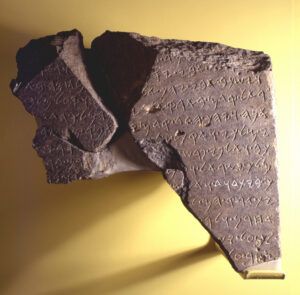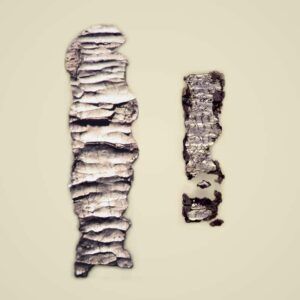Nothing helps us better understand the lives of the people who have lived in Israel than the archaeological artifacts that are dug up here. The study of archaeology is of great significance because it helps inform us all about where we come from. The field assumes additional importance in the context of contested lands — the artifacts and findings revealed in the Holy Land represent crucial evidence of the lifestyle of Jews living here many centuries ago.
Civilizations have risen and fallen on this hallowed land and their histories have been preserved in the relics they left behind. However, some treasures that have been found beneath the earth of Israel are arguably more significant than others. Specifically, those that support the historicity of the Hebrew Bible.
Here are some of the most important archaeological finds in Israel.
Join the fight for Israel’s fair coverage in the news
The House of David Victory Stone – 1993
Also known as the Tel Dan Stele, this slab of stone that was found in northern Israel in 1993 provides proof of Israel’s most famous ruler. The Aramaic inscription carved into it offers the first evidence of King David’s dynasty outside of Biblical sources.
It has been dated to the eighth or ninth century BCE and appears to recount the victory of King Hazael of Aram-Damascus, Syria, over King Joram of Israel and King Ahaziah of the House of David. This account differs from the Book of Kings, which states Jehu killed Joram and Ahaziah before taking the Israeli throne. The fragmented inscription reads:
[…] and cut […] my father went up [against him when] he fought at […] And my father lay down, he went to his [ancestors]. And the king of I[s]rael entered previously in my father’s land. [And] Hadad made me king. And Hadad went in front of me, [and] I departed from [the] seven […]s of my kingdom, and I slew [seve]nty kings, who harnessed thou[sands of cha]riots and thousands of horsemen (or: horses). [I killed Jeho]ram son of [Ahab] king of Israel, and [I] killed [Ahaz]iahu son of [Jehoram kin]g of the House of David. And I set [their towns into ruins and turned] their land into [desolation …] other [… and Jehu ru]led over Is[rael … and I laid] siege upon […]”
Providing undisputed evidence of the rule of David, the Tel Dan Stele is perhaps the most important relic of Biblical significance to have ever been found in the Jewish state.

King Solomon’s Wall – 2010
A three-month excavation in Israel’s capital Jerusalem, just over a decade ago, uncovered a section of a wall that is believed to date from the tenth century BCE. Influential archaeologist Dr. Eilat Mazar of Jerusalem’s Hebrew University led the dig in a location known as the Ophel, close to the Temple Mount. The wall, which is an impressive 70 meters long and six meters high, appears to confirm the Book of the Kings’ account of King Solomon building a huge defensive barrier in Jerusalem (1 Kings 3:1).
“We don’t have many kings during the tenth century that could have built such a structure, basically just David and Solomon,” Dr. Mazar said in 2010. “This is the first time that a structure from that time has been found that may correlate with written descriptions of Solomon’s building in Jerusalem.” Other relics found at the site appear to support her assertion. They included figurines of women that symbolize fertility, as well as jar handles inscribed with the message “to the king” and seals that bear Hebrew names.
Hezekiah’s Tunnel – 1867
Charles Warren discovered Hezekiah’s Tunnel in 1867, after being sent to conduct excavations close to the Temple Mount. The tunnel, which was constructed around the eighth century BCE, formed part of a system used to transport water from the Gihon Spring to within the city’s walls. Its discovery also confirms the Biblical account of Hezekiah preparing the city for a siege led by Assyrians after the King of Judah offended Assyrian King Sennacherib. An inscription found on the tunnel wall confirms this feat of engineering was made possible by two teams using axes, who dug through rock and gravel from opposite ends until they eventually met in the middle.
Ketef Hinnom Amulets – 1979
Excavation works undertaken in 1979 at a tomb dating back to the seventh century BCE in Ketef Hinnom, southwest of Jerusalem’s Old City, uncovered something remarkable: Two tiny silver scrolls that would have originally been worn as amulets. It took three years for the scrolls to be carefully unrolled, and while most of the text on them was indecipherable due to how much they had disintegrated, experts quickly realized their significance.
They are the earliest written passage of the Hebrew Bible, even predating the famous Dead Sea Scrolls by around 400 years. Part of one inscription is a version of Numbers 6:24-26: “The Lord bless you and protect you! The Lord deal kindly and graciously with you! The Lord bestow His favor upon you and grant you peace!”
Related Reading: 10 Questions About the Dead Sea Scrolls Answered

Jerusalem’s City Wall – 2021
Just this month, archaeologists working in the City of David National Park made an exciting announcement that confirms the Biblical description of the Babylonian invasion of Jerusalem led by King Nebuchadnezzar in 586 BCE, and the exile of the Jewish people that followed. The discovery of the ancient wall, which is five meters wide, proves Bible accounts of Jerusalem being fortified by a huge structure.
Dr. Filip Vukosavovic of the Ancient Jerusalem Research Center coordinated the excavations alongside Dr. Joe Uziel and Ortal Chalaf on behalf of the Israel Antiquities Authority. “When we exposed the first part of the wall, an area of about one meter by one meter great, I immediately understood what we had found,” Dr. Vukosavovic said. “I almost cried.”
Liked this article? Follow HonestReporting on Twitter, Facebook, Instagram and TikTok to see even more posts and videos debunking news bias and smears, as well as other content explaining what’s really going on in Israel and the region.
New! Skip the social scroll and get the latest from HonestReporting via Telegram.


